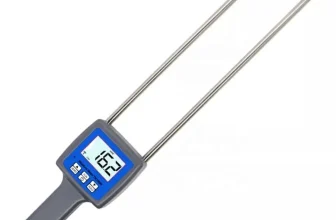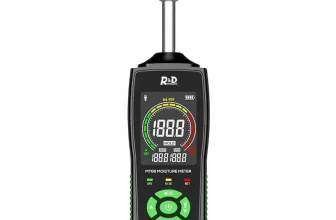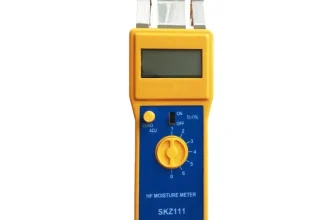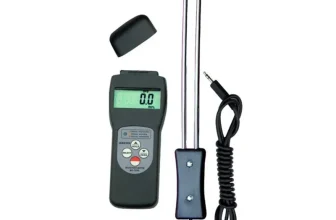Firewood has always been a primary source of fuel for many households
globally. Its significance is rooted in its cost-effectiveness and
availability, making it a preferred choice for heating and cooking. The
process of burning firewood is not just a silent witness to our cozy
conversations around winter fireplaces; it is deeply attached to the
fundamental aspects of human existence and survival.
Moreover, using firewood is not just economical, it can also be
sustainable when the wood is harvested responsibly. It is considered
carbon-neutral, meaning the carbon dioxide released during burning
equals the amount absorbed while the tree was growing. This helps in the
natural carbon cycle, and contrary to fossil fuels, doesn’t contribute
to the additional accumulation of greenhouse gases.
However, the quality of the firewood significantly impacts its
efficiency and environmental effect. That’s why understanding and
monitoring the moisture content of firewood becomes critical. Burning
firewood with the correct moisture content is essential for safe and
efficient heating, and for reducing negative impacts on the
environment.
Need for Correct
Firewood Moisture Levels
Correct firewood moisture levels are paramount for numerous reasons.
First, burning firewood with the right moisture content increases the
efficiency of your stove or fireplace. It yields more heat, burns
cleaner, and helps maintain the lifespan of your woodstove. Second,
firewood with too much moisture might smoke heavily, creating a
unpleasant and unhealthy environment in your home. Furthermore, too much
moisture can increase the creation of creosote, a harmful by-product
that can build up and potentially spark a dangerous chimney fire.
Therefore, it’s essential to identify and maintain the appropriate
moisture level in your firewood to ensure optimal performance, safety,
and enjoyability of your heat source.
What is a Firewood Moisture
Meter?
Definition
A firewood moisture meter is a specialized device designed to
determine the moisture content in firewood. It works by sending an
electric current between two prongs that are inserted into the wood. The
resistance to this current, which changes based on the wood’s moisture
content, is measured and then interpreted by the device to give a
percentage reading. This reading indicates how much water is present in
the wood relative to the wood’s total weight. This tool provides a quick
and easy way to check whether your firewood is dry enough to burn
efficiently or if it needs more time to season. Hence, it’s a vital tool
for anyone who relies on burning wood for heating or cooking.
The Design and How it
Functions
A firewood moisture meter is a portable handheld device, designed
with a digital or analog display screen and two prongs, scientifically
referred to as electrodes or pins. The prongs are the crucial components
that make this device function effectively.
To go into detail about how it functions, the user must insert these
two prongs into a piece of firewood. The device then passes a small
electrical current between these two prongs. Since water is a good
conductor but wood is not, the resistance to this electrical current is
measured. High resistance indicates low moisture content, while low
resistance signals high moisture content. The built-in microprocessor
then calculates this resistance into a percentage representing the
moisture content in the wood, which is displayed on the screen.
It’s important to remember that you must press the prongs deep enough
into the wood for accurate readings – usually about ¼ to ½ inch,
depending on the model of the meter. Furthermore, you should take
readings from different areas of the firewood log as moisture content
can vary from one area to another. This will provide an average moisture
level across the log.
In sum, the firewood moisture meter is ingeniously designed to offer
an intuitive and straightforward way of determining the moisture content
in your firewood, ensuring you have the best quality for effective,
efficient, and safe burning.
Types of Firewood Moisture
Meters
There are primarily two types of firewood moisture meters available
in the market – pin-type and pinless.
Pin-type firewood moisture meters come with two small metal probes or
‘pins’ that must be inserted into the firewood to estimate the moisture
content. They work by passing a small electrical current between the two
probes. If the wood is wet, the current will flow freely between the
probes, implying higher moisture content. Conversely, if the wood is
dry, the current will pass slowly or not at all, indicating a lower
moisture level.
On the other hand, pinless moisture meters operate a bit differently.
Instead of having physical probes, they use sensors that can detect the
moisture level when placed flat against the firewood’s surface. They
employ electromagnetic waves to gauge the moisture content. Since these
devices only require surface contact, many users find them less invasive
and easier to use than their pin-based counterparts.
Both types have their own set of advantages and possible drawbacks.
While pin-type meters provide more specific readings, they can leave
small holes in the wood. On the contrary, pinless meters offer a
non-destructive method of measuring moisture levels but may not be as
precise in comparison to pin-type meters.
Importance of a
Firewood Moisture Meter
Accurate Measurement
of Moisture Content
A firewood moisture meter is an invaluable tool for ensuring the
accurate measurement of your firewood’s moisture content. The device
operates by sending a small electrical current through the wood, where
it encounters resistance from the moisture content within. The level of
resistance is then translated into a percentage, giving you an exact
figure of the moisture content.
Why is this important, you might wonder? The answer lies in the fact
that firewood’s moisture content can greatly affect how well it burns.
Firewood, ideally, should have a moisture content of less than 20%. This
level allows the wood to burn efficiently, produce more heat, and
minimize the amount of smoke produced.
A firewood moisture meter removes the guesswork from determining
whether your firewood is ready to burn. It helps avoid the common
mistake of burning unseasoned or damp firewood which is hard to light,
burns poorly, and produces excessive smoke. With a firewood moisture
meter, you are assured of getting accurate readings at all times,
helping to maximize the performance of your firewood stove or
fireplace.
Importance of Burning Dry
Firewood
Burning dry firewood is critical for several reasons. The moisture
content of the firewood directly impacts its burning efficiency. When
wood is too wet, it does not burn evenly, leading to sporadic fires that
can be quite frustrating to manage. Furthermore, damp wood produces more
smoke and less heat, undermining both its functional and economic
efficiency.
On the other hand, dry firewood burns much hotter and more steadily,
offering you a controlled and efficient burn. It can light up quickly,
provide consistent heat, and last for considerable durations, providing
maximum output for your heating requirements.
Also, using dry firewood reduces the risk of creosote buildup in your
flue. Creosote is a sticky, highly inflammable substance that can lead
to chimney fires. Wet wood tends to produce more creosote due to
incomplete combustion, posing a significant risk to your home
safety.
In short, burning dry firewood is economical, safe, and results in a
more pleasant experience overall, irrespective of whether you burn
firewood for heat or for recreational purposes. A firewood moisture
meter assists in making sure that your firewood has the optimal moisture
content, thus, ensuring you enjoy all these benefits.
Relation
Between Firewood Moisture Levels and Heating Efficiency
Wood moisture content can greatly impact the heating efficiency of
your fire. Dry firewood, generally regarded as having a moisture content
below 20%, produces more heat and burns better than wet or unseasoned
firewood. This is because dry wood has fewer water molecules that need
to be evaporated, resulting in more energy being released as heat rather
than being used up in the evaporation process.
Wet or unseasoned firewood, on the other hand, has a high moisture
content which requires a lot of energy to evaporate. This means much of
the energy generated by the fire is used to dry the wood rather than to
heat your space. This can result in a cool, smoky, and inefficient fire.
Moreover, wet firewood tends to produce a lot of smoke, which can lead
to the buildup of creosote, a flammable substance, in your chimney.
Therefore, by ensuring that your firewood has the appropriate
moisture content using a firewood moisture meter, you can increase the
heating efficiency, producing a warmer, cleaner, and safer fire. By
maintaining optimal heating efficiency you not only save on fuel but
also contribute to a cleaner and safer environment.
Environmental
Impact of Burning Wet Firewood
Burning wet firewood has a significant environmental impact. The
process unleashes a deluge of smoke into the atmosphere which is teeming
with harmful pollutants such as particulate matter and carbon monoxide.
These pollutants can cause various health issues including respiratory
problems, heart disease, and environmental allergies.
Furthermore, the excessive smoke from wet firewood contributes to
smog and air pollution, greatly reducing air quality, particularly in
urban areas where burning wood is prevalent. The smog and soot particles
can drift away, spreading pollution over larger areas and impacting the
health of distant communities and contributing to poor visibility
conditions.
Moreover, burning wet firewood is less efficient, leading to more
wood being burned than necessary, thus exacerbating deforestation and
habitat loss. As trees play a vital role in absorbing carbon dioxide,
excessive tree cutting for firewood can contribute to increased levels
of greenhouse gases in the atmosphere, exacerbating climate change.
This is where a firewood moisture meter comes into play. An accurate
moisture meter ensures that you are burning dry firewood, which not only
reduces your contribution to air pollution but also promotes efficient
heating and minimizes the unnecessary felling of trees.
How to Use a Firewood
Moisture Meter
Step-by-step Guide
Before you start using your firewood moisture meter, ensure it’s
calibrated according to the guidelines mentioned in the user manual.
Once that’s done, follow these steps for using the meter:
Step 1: Choose a piece of firewood you wish to measure. If you have
just split the wood, choose one of the freshly split pieces for a more
accurate reading.
Step 2: Turn on your meter as per the instructions given in its
manual.
Step 3: Position the meter’s probes on the selected piece of
firewood. Most firewood moisture meters are equipped with two metal
probes, and these should be inserted into the wood. Aim to get these
probes into the wood about 1 inch deep.
Step 4: Allow the meter to take the moisture reading. Your meter will
then calculate the water content of your firewood and display a reading,
usually in percentage form.
Step 5: Practice taking multiple readings from different areas of the
same piece of firewood and use the average of these readings.
Step 6: Use the readings to assess the moisture content of your
firewood. If the moisture percentage is above 20%, that firewood is not
ready for burning, as it will produce a lot of smoke and less heat.
Optimally, the moisture content in firewood ready for burning should be
between 15-20%.
Remember, getting accurate readings requires practice and
understanding of how to interpret the readings as per usage
requirement.
Tips and Tricks for
Accurate Reading
Ensuring an accurate reading with your firewood moisture meter
involves a few good practices. Firstly, make sure your meter is properly
calibrated. Most meters come already calibrated from the factory, but it
is a good idea to check the instruction manual to be sure.
Next, the placement of the meter’s prongs matter. Don’t just randomly
stick the prongs into the firewood. Instead, take advantage of the split
ends of the firewood. Insert the prongs into the freshly split surfaces
since the outside of firewood can often be drier than the inside. This
will most accurately reflect the moisture content that will be relevant
when burning the wood.
Make sure the probes are fully inserted into the wood, to the depth
specified by the manufacturer. If the probes aren’t in far enough,
readings could be less accurate.
It is also advisable to test multiple pieces of wood and in different
spots. Wood is an organically diverse material, and moisture levels can
vary from piece to piece and even within a single piece.
Remember, it’s not just about sticking the prongs in once and reading
the result. Taking multiple measurements and averaging them out will
give you the most accurate indication of your firewood’s moisture
content.
Reading and Interpreting
the Results
Interpreting results from a firewood moisture meter is as critical as
the measuring process itself. Once you’ve inserted the probe into the
firewood, the device delivers a reading on its screen, represented as a
percentage, that illustrates the moisture content.
As a general rule, firewood with a moisture content of less than 20%
is considered perfect to burn. This is because it’s dry enough to burn
efficiently, but still retains enough moisture to prevent it from
burning too quickly. If your reading ranges between 20% to 25%, it
indicates that the wood is borderline and needs a little more time to
dry out. Anything above 25% suggests the wood is too wet to burn
efficiently and should be dried further before use.
Furthermore, it’s significant to note that readings may vary slightly
depending on the type of wood. Therefore, to get an accurate
perspective, it’s recommended to test multiple pieces across different
parts of the log. This approach helps you get a more realistic average
moisture content.
An understanding of these values and what they represent forms the
basis of correctly interpreting the results from a firewood moisture
meter. The ultimate goal is to ensure you are working with firewood that
is ideal for burning – efficient, safe, and environmentally
friendly.
Choosing the Right
Firewood Moisture Meter
Factors to Consider
When choosing the right firewood moisture meter, various factors come
to the fore. Firstly, the accuracy of the device is paramount as it
directly impacts its function – getting precise moisture readings. Look
for a device with a strong reputation for delivering accurate
results.
Secondly, consider the range of the moisture meter. It should ideally
be capable of detecting moisture levels anywhere between 5% to 40%,
which covers most use-cases in the context of firewood.
Thirdly, durability is a crucial factor. The meter should be able to
withstand heavy-duty use, particularly if you’ll be using it frequently
or in harsh environments.
In addition, user-friendliness is something to consider. The device
should be easy to use and have a readable, preferably digital, display.
Look for devices with clear, simple instructions and an intuitive
interface.
Lastly, check for features like automatic temperature compensation,
which ensures accuracy even in fluctuating temperatures. Some models
offer added features such as backlit displays and species correction –
the ability to adjust readings based on the type of wood. However, know
that while such features can contribute to convenience and accuracy,
they might also add to the cost.
Price and Availability
When selecting a firewood moisture meter, price and availability are
key elements to consider. These devices range in cost, with some
budget-friendly options available, as well as more expensive models that
come with additional features. It’s important to select a meter that
fits within your budget but also meets your specific needs. Keep in mind
that investing in a higher-priced model may offer longer durability and
more accurate readings.
Additionally, availability can be another deciding factor in your
selection process. Firewood moisture meters are readily available in
most home improvement stores as well as online marketplaces like Amazon,
eBay, and others. When purchasing online, ensure to take into account
factors such as shipping times and costs. Consider also the supplier’s
reliability and the provision of after-sales service, as having access
to customer support can be invaluable if you encounter problems with
your meter. It’s advantageous to compare different brands and models,
read customer reviews, and make an informed decision on the best
firewood moisture meter for your needs.
Reviews and Recommendations
When it comes to choosing the right firewood moisture meter, reviews
and recommendations from experienced users can be extremely valuable.
Firstly, look at the overall star ratings. Products with higher ratings
are generally dependable. However, don’t rely solely on this factor.
It’s prudent to delve deeper and read some of the reviewers’
comments.
Some users may provide insights into specifics that could influence
your decision, such as how precise the moisture readings are or how
durable the device is. Pay attention to repeated praises or criticisms,
as these will likely reflect consistent qualities about the product.
Apart from customer reviews, expert recommendations also hold
substance. Industry professionals often subject these tools to intensive
tests, and their observations and endorsements can provide an extra
layer of assurance. Many home improvement websites or woodworking forums
have sections dedicated to recommending the best tools in the industry,
so be sure to check these out as well.
Above all, ensure the feedback and recommendations align with your
particular needs. A firewood moisture meter perfect for frequent
domestic use may differ greatly from one built for occasional or
professional use.
Conclusion
Summary
of the Importance and Use of Firewood Moisture Meters
Firewood moisture meters play an integral role in ensuring the
optimal use of firewood. They assist in accurately ascertaining the
moisture content in firewood, which is crucial for efficient burning.
The use of dry firewood, as determined by the meter, leads to more heat
production and less smoke, thereby enhancing the heating efficiency and
being kinder to the environment. Learning to use a moisture meter
correctly enables better interpretation of results, guiding the user’s
choices in firewood selection. Thus, investing in a quality firewood
moisture meter is a worthy home or professional consideration for the
benefits it brings to heating, environmental conservation, and financial
savings.
Encouragement for
the Proper Use of Firewood
Whether you’re a seasoned wood burner or a novice looking to heat
your home more affordably and naturally, investing in a firewood
moisture meter is a smart choice. It’s your trusted ally in ensuring
that your firewood has optimal moisture levels and also reducing wood
smoke, which is hazardous to both your health and our environment. The
right firewood can make a world of difference in your overall heating
experience, leading to optimal heat output, increased wood-burning
efficiency, and a cleaner environmental footprint. So, fuel your fires
wisely for a cozy, warm, and environmentally-friendly home. After all,
there’s nothing quite like the crackle of correctly dried firewood in a
stove or fireplace. Happy burning!







